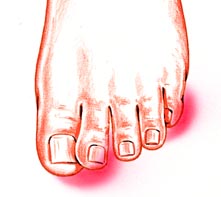 Many disorders can affect the toes, causing pain and discomfort. These disorders can prevent your foot from functioning the way it should. Overlapping toes are a common deformity, characterized by one toe lying on top of an adjacent toe. It can occur in any of the toes, although the second toe or the fifth toe are more commonly involved. This condition can cause extreme pain and irritation.
Many disorders can affect the toes, causing pain and discomfort. These disorders can prevent your foot from functioning the way it should. Overlapping toes are a common deformity, characterized by one toe lying on top of an adjacent toe. It can occur in any of the toes, although the second toe or the fifth toe are more commonly involved. This condition can cause extreme pain and irritation.
Causes
Overlapping toes tends to be an inherited condition that runs in families usually due to improper biomechanics of the foot. Although it also can develop in the womb depending upon the position of the fetus.
Additionally, improperly fitted footwear is another common cause for overlapping toes. When fitting shoes, the toe box of the shoe should match the shape of your foot. However, if your toes are crowded and are being forced into a toe box shape that doesn’t match the shape of your foot, your toes will overlap.
Overlapping toes can cause other foot conditions, such as corns, calluses, metatarsalgia and bunions.
Treatment
Any pain or discomfort in the toes should be given prompt attention. If you have overlapping toes, a custom fitted ezWalker® can support your foot to reduce pressure on the toes while reducing pain and discomfort, and adding balance, stability, and strength to every step.
You should choose a properly fitted shoe that has a deep toe-box to accommodate this toe deformity.
Overlapping toes can be comforted with products like gel toe straighteners and toe combs to keep the toes apart. Other products, such as gel toe shields and caps, also may be recommended to eliminate friction between your shoe and your toe joint, and to provide lubrication and comfort. These comfort products can be used in conjunction with deep toe-box shoes and a custom fitted ezWalker® for overall relief.
In some cases, surgery may be required to release the permanant shortening of the joint. And in severe cases, a pin may be needed to keep the toe in a straightened position.
Ignoring symptoms can aggravate the condition and lead to a breakdown of tissue, infection, and possible loss of a toe. If your overlapping toes become inflamed, heavily callused, develop open sores, or bleed, you must seek the counsel of a physician.
Your feet are constantly changing throughout your life. You should have your shoe fit checked regularly. Remember, the size on the measuring device is only a reference. Mass-manufactured shoes are NOT all created equal. Refer to the Shoe Fitting Guide for proper guidelines on how to best fit your shoes.
If you follow these guidelines and your pain persists, you must seek the counsel of a physician for proper diagnosis and treatment. Overlapping toes can lead to a breakdown of tissue which can cause serious complications.

